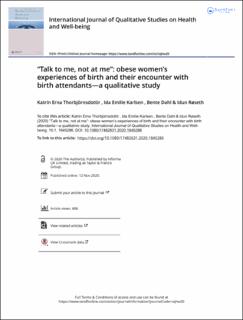| dc.contributor.author | Thorbjörnsdottir, Katrin Erna | |
| dc.contributor.author | Karlsen, Ida Emilie | |
| dc.contributor.author | Dahl, Bente | |
| dc.contributor.author | Røseth, Idun | |
| dc.date.accessioned | 2021-05-10T13:04:34Z | |
| dc.date.available | 2021-05-10T13:04:34Z | |
| dc.date.created | 2020-11-12T20:56:01Z | |
| dc.date.issued | 2020 | |
| dc.identifier.citation | International Journal of Qualitative Studies on Health and Well-being. 2020, 15 (1), 1-10. | en_US |
| dc.identifier.issn | 1748-2623 | |
| dc.identifier.uri | https://hdl.handle.net/11250/2754714 | |
| dc.description.abstract | Purpose: To explore the birth experiences of obese women in regard to their encounter with birth attendants. Methods: Qualitative, in-depth interviews with 10 women were conducted in February 2020. Data were analysed using a descriptive phenomenological method. Results: Four interrelated constituents were identified: The preconception and prejudice of being unhealthy and less able; Being unique among all the other unique women; “Talk to me, not at me”—the importance of information and communication, and; Feeling secure enough to be in the 'birthing bubble'. Conclusion: For the women in our study, being obese meant experiencing challenges as well as opportunities during childbirth and in their encounter with birth attendants. Experiences of preconceptions, alienation, a focus on risk, and a loss of autonomy in encounters with birth attendants were found to negatively impact the birthing process. The women desired affirmative and inclusive encounters; these kinds of encounters may improve the birth experiences of obese women. | en_US |
| dc.language.iso | eng | en_US |
| dc.rights | Navngivelse 4.0 Internasjonal | * |
| dc.rights.uri | http://creativecommons.org/licenses/by/4.0/deed.no | * |
| dc.subject | Fedme | en_US |
| dc.subject | Obesity | en_US |
| dc.subject | Fenomenologi | en_US |
| dc.subject | Fenomenology | en_US |
| dc.subject | Fødselsomsorg | en_US |
| dc.subject | Maternity care | en_US |
| dc.title | “Talk to me, not at me”: obese women’s experiences of birth and their encounter with birth attendants—a qualitative study | en_US |
| dc.type | Peer reviewed | en_US |
| dc.type | Journal article | en_US |
| dc.description.version | publishedVersion | en_US |
| dc.rights.holder | © The Author(s) 2020. | en_US |
| dc.subject.nsi | VDP::Psykologi: 260 | en_US |
| dc.subject.nsi | VDP::Psychology: 260 | en_US |
| dc.subject.nsi | VDP::Psykologi: 260 | en_US |
| dc.subject.nsi | VDP::Psychology: 260 | en_US |
| dc.source.volume | 15 | en_US |
| dc.source.journal | International Journal of Qualitative Studies on Health and Well-being | en_US |
| dc.source.issue | 1 | en_US |
| dc.identifier.doi | https://doi.org/10.1080/17482631.2020.1845286 | |
| dc.identifier.cristin | 1847557 | |
| cristin.ispublished | true | |
| cristin.fulltext | original | |
| cristin.qualitycode | 1 | |

